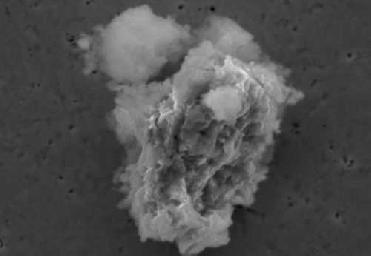
Credit: Guillermo Muñoz y Virginia Souza-Egipsy (CAB) / SINC.)
PARIS: Both a Spanish and a French astrophysicist have identified a band in the infrared range that serves to track the presence of organic material rich in oxygen and nitrogen in the interstellar dust grains. Should any telescope detect this band, the presence in space of aminoacids and other substances, which are the precursors to life, could be confirmed.
"We have proved in the laboratory that an organic material of prebiotic interest known as yellow stuff possesses a very characteristic absorption band that can be searched for in zones in space which have dust grains in order to try and identify similar substances", Guillermo Muñoz, a researcher at the Centre for Astrobiology (INTA-CSIC), points out to SINC.
The scientist explains that the dust grains observed in the interstellar clouds and around the young stars are usually "surrounded by tiny mantles of ice rich in water and other simple molecules, such as carbon monoxide (CO), methanol (CH3OH) or ammonia (NH3), upon which light and cosmic rays fall".
Muñoz and his French colleague Emmanuel Dartois, from the Institute of Space Astrophysics in Paris (France), have recreated these interstellar conditions in the laboratory by mixing various gases at a very low pressure and temperature (-263ºC), and then irradiating the interstellar ice which is formed with ultraviolet light. As a result yellow stuff is generated, a yellowish substance rich in carbon but with hydrogen, nitrogen and a lot of associated oxygen. This material is composed of numerous organic molecules, such as carboxylic acids, glycine and other aminoacids (molecules that are essential to the composition of proteins).
The yellow stuff absorption band is situated within the 3.4 micrometres of the mid-infrared spectrum and when represented on a graph its profile has two characteristic peaks. "This makes it possible to detect this band in planet-forming regions similar to our solar nebula and Solar System bodies", Muñoz points out.
"Moreover the synthesis of organic compounds by ice irradiation could be related to the presence of this substance in comets, such as the Halley comet, and could explain also the isotopic composition of the carbonaceous material detected in interplanetary dust and in types of meteorites rich in carbon which are known as carbonaceous chondrites", he adds.
Until now scientists have not observed the yellow stuff infrared band in interstellar space, and the same is true for Solar System bodies, but they do postulate that this could be due to the limitations in present techniques. In the case of carbonaceous chondrites and interplanetary dust, both contain carbon associated with heavy hydrogen isotopes (deuterium above all, 2H) and nitrogen (15N) characteristic of chemical reactions at very low temperatures, such as those generated in irradiated ice, but that type of meteoritic carbon is different to yellow stuff.
The prebiotic substances derived from the irradiation of ice lose their organic character and high hydrogen, nitrogen and oxygen content when heated at more than 300 ºC; this occurs in the proximities of the Sun. "That type of heated yellow stuff, which still maintains a high content of heavy isotopes, could be the sort that is found to form part of the carbonaceous chondrites and interplanetary dust", Muñoz points out to SINC.
The Rosetta space probe belonging to the European Space Agency will try to detect aminoacids and other molecules of prebiotic interest in the central core of the Comet 67P/Churyumov-Gerasimenko, when the probe arrives there in 2014.
(Plataforma SINC (2009, March 26). Does Prebiotic Material Exist In Space?)














The Indian Air Force, in its flight trials evaluation report submitted before the Defence Ministry l..
view articleAn insight into the Medium Multi-Role Combat Aircraft competition...
view articleSky enthusiasts can now spot the International Space Station (ISS) commanded by Indian-American astr..
view article